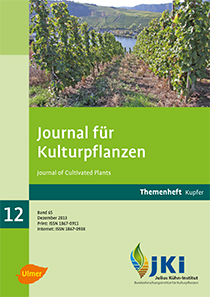Influence of copper on the activity of soil microorganisms in selected German vineyards
DOI:
https://doi.org/10.5073/JfK.2013.12.02Keywords:
Viticulture, soil pollution, total copper concentrations, effects on soil microorganisms, activity and sum parametersAbstract
Since 2009, total copper contents were determined on different main wine culturing regions of Germany. After the selection of suitable areas which differed in the total Cu concentrations, soil properties and farming systems, an estimation of possible effects on earthworm communities and soil microorganisms was carried out. In a feasibility study a biological condition survey was performed to eight areas of quality wine producers from the vineyards of Rheinland-Pfalz, Rheinhessen, Baden and Moselle on the parameters of soil microbial communities that were sampled in autumn 2010 and spring 2011.
In all investigated soils only the soil autochthonous populations were examined. These populations were exposed to higher Cu contents for more than 50 years, and thus the microorganisms adapted to the natural site conditions on the formation of copper resistance and tolerance.
The results of the investigation of soil respiration, activity of dehydrogenase and potential nitrification, and other specific parameters such as microbial biomass metabolic quotient, and Cmic/Corg ratio are discussed in the context of bioavailable and total contents of copper and physico-chemical soil properties. The test soils were compared with the corresponding untreated control.
However, a strong correlation between increasing copper content and lasting influence on the activity of the microorganisms in the studied soils could not be found. Other soil parameters seem to better influence such activities.
This could be related to the fact that the bioavailability of copper is influenced by other parameters (for example, particle size distribution of organic carbon, cation exchange capacity, pH). In addition, aging and sequestration processes can reduce the toxicity against soil-borne microorganisms.
Downloads
Published
Issue
Section
License
The content of the journal is licensed under the Creative Commons Attribution 4.0 License. Any user is free to share and adapt (remix, transform, build upon) the content as long as the original publication is attributed (authors, title, year, journal, issue, pages).
The copyright of the published work remains with the authors. The authors grant the Journal of Cultivated Plants, the Julius Kühn-Institut and the OpenAgrar repository the non-exclusive right to distribute and exploit the work.







